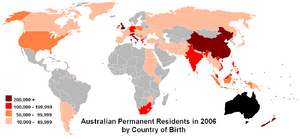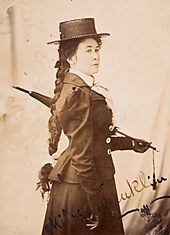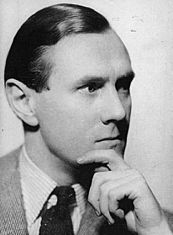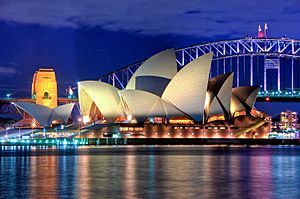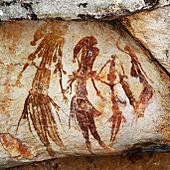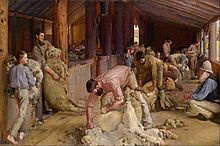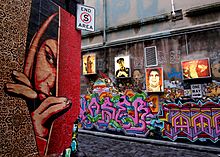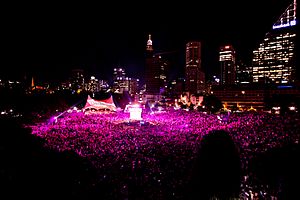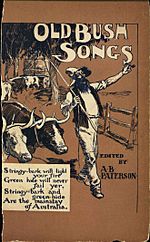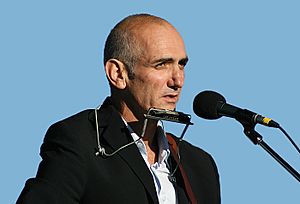Culture of Australia facts for kids
The culture of Australia is a mix of different influences. It started mainly from Britain, but also got its unique flavor from Australia's special land and the amazing cultures of Aboriginal and Torres Strait Islander peoples.
British people first came to Australia in 1788. After that, many people from different countries moved there. Australia's strong link to Britain can be seen in its main language, English, and its democratic government. This government system is like Britain's, with a parliament and a King or Queen. Christianity is also the main religion.
Aboriginal people arrived in Australia as early as 60,000 years ago. Their art dates back at least 30,000 years! Some parts of Australia were first set up as places for prisoners, with the first British ships arriving in Sydney in 1788. Stories about famous outlaws, like the bushranger Ned Kelly, are still popular in Australian music, movies, and books.
The gold rushes in the 1850s brought lots of wealth and new social changes. The Australian colonies were ahead of many Western countries in setting up elected parliaments and giving rights to workers and women.
Australia became a united country in 1901. This was after a strong feeling of national identity grew in the late 1800s. Artists like the Heidelberg School painters and writers such as Banjo Paterson and Henry Lawson helped shape this feeling. The World Wars also greatly changed Australia's identity. World War I created the legend of the ANZAC soldiers. After World War II, Australia became closer to the United States as an ally. Millions of migrants from 200 nations arrived after the second war, bringing amazing new diversity. Their food, lifestyles, and traditions have become a big part of Australian culture.
Contents
Australian Culture Through Time

The oldest cultures in Australia belong to the Aboriginal and Torres Strait Islander peoples. Their ancestors lived in Australia for 40,000 to 60,000 years, living as hunter-gatherers. In 2006, about 2.5% of Australia's population was Indigenous. Many Aboriginal Australians believe in the Dreaming, or Dreamtime. This is about when spirits created the land and culture. It also includes the knowledge and practices that guide their lives.
The meeting of Indigenous and non-Indigenous Australians has inspired much art and literature. Ancient Aboriginal art styles and inventions like the boomerang and didgeridoo are now symbols of modern Australia.
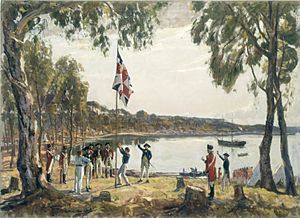
When the first British settlers arrived in Sydney in 1788, they brought Western culture to Australia. Even though Sydney was first a place for prisoners, the British laid the groundwork for Australia's democratic government and laws. They also brought English literature, Western art, music, and Christian beliefs.
The British Empire spread across Australia and set up six colonies. Most were for prisoners, but South Australia was a "free colony." It was meant to be a place with political and religious freedoms, and chances for wealth.
Indigenous Australians and new settlers sometimes got along, but there was also conflict. European diseases were very harmful to Aboriginal people and their culture.
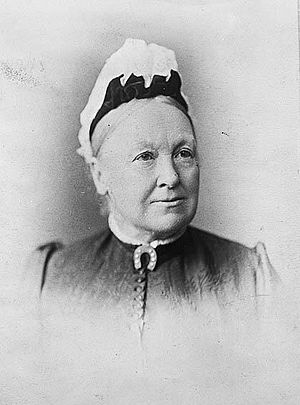
From the 1850s, the colonies created their own democratic parliaments. They became Constitutional Monarchies with Queen Victoria as the head of state. Women gained the right to vote in Australia from the 1890s. South Australia was the first in the world to allow women to run for political office in 1895. In 1897, Catherine Helen Spence became the first female political candidate.
During the colonial period, unique Australian art, music, language, and literature began to grow. Painters from the Heidelberg School and poets like Henry Lawson and Banjo Paterson helped create an Australian spirit that valued equality and friendship (called "mateship"). Sports like cricket and rugby came from Britain. A local game, Australian Rules Football, also became a cherished tradition.
Australia became a country in 1901. The Australian Constitution set up a federal democracy. It included important rights like the right to vote, trial by jury, and freedom of religion. The Australian Labor Party and the Liberal Party became the main political parties. Voting is required in Australia. The government is formed by the party with the most seats in the Australian House of Representatives, and their leader becomes the Prime Minister. Australia is still a constitutional monarchy, with a Governor General representing the monarch.
Australia fought alongside Britain in World War One and World War Two. These wars deeply affected Australia's national identity. The ANZAC troops became symbols of mateship, courage, and strength for the nation.
After Federation in 1901, Australia had a policy called the White Australia Policy. This policy preferred British migrants. After World War II, this policy was removed. This allowed many migrants from Southern Europe, and later Asia and the Middle East, to come to Australia. By the 1970s, the government was promoting multiculturalism.
Some states had laws that limited voting rights for Aboriginal people until the 1960s. Then, full legal equality was achieved. In 1967, Australians voted to include all Aboriginal people in the national census. In 1984, a group of Pintupi people living a traditional hunter-gatherer life were found in the Gibson Desert. They are thought to have been the last uncontacted tribe.
While British culture remained strong, other influences grew. Surfing, from Hawaii, became popular. American pop culture and movies were also embraced, especially with the arrival of television. The 1956 Melbourne Olympics showed Australia as a confident nation. New cultural figures like country music star Slim Dusty and comedian Barry Humphries expressed a unique Australian identity.
Today, Australia's immigration program welcomes skilled migrants, families, and refugees. By 2010, over 6.5 million migrants from 200 countries had arrived since World War II. Australia's population tripled to about 21 million by 2010. More than 43% of Australians were born overseas or have a parent born overseas. Most Australians live in cities along the coast.
Modern Australia is a diverse society. It values democracy, informality, and equality. While its Anglo-Celtic roots are strong, migration has shaped all parts of Australian life, including business, arts, food, humor, and sports.
Symbols of Australia
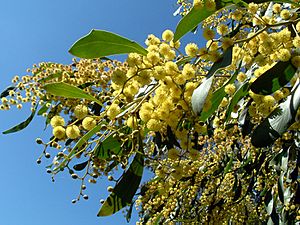
When Australia became a country in 1901, a competition was held to design an Australian flag. The chosen design has the Union Flag (from the UK) in the corner, showing Australia's history with Britain. The Southern Cross stars show Australia's location. The seven-pointed Federation Star represents the six states and territories. Other official flags include the Australian Aboriginal Flag and the Torres Strait Islander Flag.
The Australian Coat of Arms was given by King George V in 1912. It has a shield with symbols of the six states. Above the shield is a seven-pointed gold star. A red kangaroo and an emu support the shield.
Green and gold became Australia's national colors in 1984, though sports teams used them much earlier. The Golden Wattle was made the national flower in 1988.
Australia is a constitutional monarchy, so it has royal symbols. These include symbols of the monarch and their representatives. The Australian currency has an image of the reigning monarch, Queen Elizabeth II. Many places are named after royal family members, like the states of Queensland and Victoria.
Language in Australia
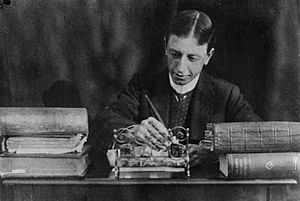
Australia doesn't have an official language, but Australian English is the main one. It has its own unique accents, pronunciations, and words. Its spelling is more like British English. In 2011, about 80% of Australians spoke only English at home. Other common languages are Mandarin, Italian, and Arabic. Almost all migrants speak some English. Australia also has a sign language called Auslan.
Before Europeans arrived, there were 200 to 300 Australian Aboriginal languages. Now, only about 70 survive, and most are in danger. For 0.25% of the population, an Indigenous language is their main language.
Australian Humor
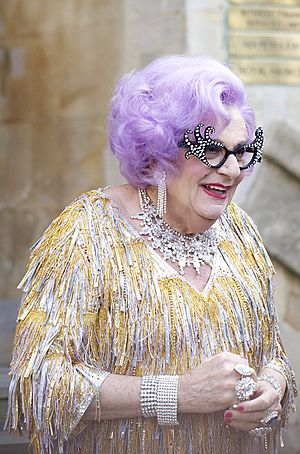
Comedy is a big part of Australian identity. Australian humor is often described as dry, cheeky, and ironic. Comedians like Barry Humphries and Paul Hogan show this well.
The early prisoners helped create a sense of humor that questioned authority. Poets like Henry Lawson and Banjo Paterson in the 1800s also shaped this dry wit. They wrote about life in the Australian bush. C. J. Dennis wrote funny poems in Australian slang. The Dad and Dave stories about a farming family were very popular. World War I ANZAC troops were known for their cheeky attitude towards officers and dark humor in battle.
Australian comedy often makes fun of itself. Examples include the Barry McKenzie movies, the quirky characters in "Crocodile" Dundee, and the funny suburban film The Castle. In the 1970s, talk-show host Norman Gunston became popular for his funny interviews and songs. Roy and HG playfully make fun of Australia's love for sport.
After World War II, migrant humor also grew. Comedians like Vietnamese refugee Anh Do and Egyptian-Australian Akmal Saleh brought new perspectives.
Since the 1950s, Barry Humphries has created famous characters like housewife "gigastar" Edna Everage. He is considered one of the most important comedians since Charlie Chaplin.
The annual Melbourne International Comedy Festival is one of the biggest comedy festivals in the world.
Arts in Australia
The arts in Australia—including movies, music, painting, theater, dance, and crafts—are recognized around the world. While much of Australia's art follows Western styles, Indigenous Australian art is unique. Australia's landscape and history have also shaped the art styles brought by migrants.
Australian Literature
After the time of prisoners, stories about the Australian bush and daily life became popular. Poets like Charles Harpur and Henry Kendall wrote about nature and patriotism in the mid-1800s. Rolf Boldrewood's Robbery Under Arms (1882) is a classic novel about bushrangers.

The Bulletin magazine, started in 1880, helped create the idea of an Australian national character. This character was seen as anti-authority, equal, friendly (mateship), and supportive of the "battler" (someone who struggles but keeps trying). This image was shown in the works of bush poets like Henry Lawson and Banjo Paterson. Lawson is known for his short stories, and Paterson for poems like "Clancy of the Overflow" and "The Man From Snowy River". C. J. Dennis wrote funny poems in Australian slang. Dorothy Mackellar wrote the famous patriotic poem "My Country" (1908), which celebrated Australia's unique landscape. Early Australian children's literature also featured the bush, with popular books like The Magic Pudding and Blinky Bill.
Important poets of the early 1900s include Kenneth Slessor and Judith Wright. The Jindyworobak Movement in the 1930s tried to create a unique Australian poetry using Aboriginal languages and ideas.
The Miles Franklin Award is Australia's most important literary prize. It was started by Miles Franklin, famous for her 1901 novel My Brilliant Career. Patrick White won the first award in 1957 and later the Nobel Prize in Literature in 1973. Other well-known Australian authors include Peter Carey, Thomas Keneally, Colleen McCullough, and Tim Winton.
David Unaipon was the first Indigenous author. Oodgeroo Noonuccal was the first Aboriginal Australian to publish a book of poems. Sally Morgan's My Place tells an important story of Indigenous Australian experiences.
Australian Theatre
Indigenous Australians have performed ceremonial dances for thousands of years, telling stories of the Dreamtime. European theater came to Australia with the First Fleet in 1788. The first play was performed by prisoners in 1789.
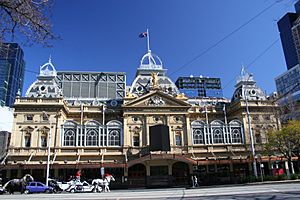
Hobart's Theatre Royal, opened in 1837, is Australia's oldest theater still in use. The Melbourne Athenaeum opened in 1839. The gold rushes in the mid-1800s helped fund the building of grand theaters, like the Princess Theatre in Melbourne.
After Australia became a country in 1901, plays showed a new sense of national identity. On Our Selection (1912), about a pioneer farming family, became very popular.
In 1955, Summer of the Seventeenth Doll by Ray Lawler featured truly Australian characters and gained international fame. That same year, Barry Humphries first performed as Edna Everage. His funny stage characters, like Dame Edna, became Australian cultural icons.
The National Institute of Dramatic Art in Sydney, founded in 1958, has famous graduates like Cate Blanchett and Mel Gibson. The Sydney Opera House, opened in 1973, is home to Opera Australia and the Sydney Theatre Company.
Australian Architecture
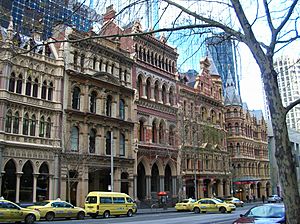
Australia has three buildings on UNESCO's World Heritage list: Australian Convict Sites (like Hyde Park Barracks and Port Arthur), the Sydney Opera House, and the Royal Exhibition Building in Melbourne. Other famous buildings include the Harbour Bridge and Parliament House, Canberra.
Before Europeans arrived, Indigenous Australians built temporary structures for housing. The first European buildings were like those in Europe. Georgian architecture can be seen in early government buildings in Sydney and Tasmania. The gold rushes of the mid-1800s led to many grand Victorian buildings in cities like Melbourne. Other important styles include the Federation style and modern designs. The Queenslander is a special house style developed for warm climates.
Religious buildings are also common, showing Australia's diverse cultures. Examples include large Christian cathedrals, the oldest Islamic building in the Southern Hemisphere (the Central Adelaide Mosque), and one of the largest Buddhist temples (Nan Tien Temple).
-
Hyde Park Barracks, Sydney.
-
Convict buildings at Port Arthur, Tasmania.
-
Inside St Mary's Cathedral, Sydney.
-
The Royal Exhibition Building, Melbourne.
-
Birdsville Hotel, an Australian pub in the outback.
-
Parliament House, Canberra.
Australian Visual Arts
Aboriginal rock art is the oldest continuous art tradition in the world, dating back 60,000 years. It's found at hundreds of thousands of sites across Australia. In the 1950s, the Hermannsburg School, led by Albert Namatjira, became famous for their desert watercolors. Many people see modern Indigenous art as a major art movement. Artists like Emily Kame Kngwarreye and Rover Thomas use acrylic paints to show their dreaming stories. This style is often called "dot painting". Art is very important to Indigenous communities, both culturally and economically.
John Glover and Eugene von Guerard were leading landscape painters during the colonial era. A unique Australian style of painting began with the Heidelberg School in the late 1800s. Artists like Tom Roberts and Arthur Streeton painted outdoors, trying to capture the bright light and colors of the Australian bush. Their works, like Shearing the Rams, helped define a growing national identity.
Sidney Nolan and Arthur Boyd were part of the Angry Penguins group. They used myth and symbolism to paint Australian landscapes. Russell Drysdale's The Cricketers (1948) shows the strange quietness of the outback.
Public art is found in many places, from the annual Sculpture by the Sea exhibitions to the "Australia's big things" roadside attractions. Australian street art has also grown, especially in Melbourne.
Major art galleries include the National Gallery of Victoria in Melbourne and the National Gallery of Australia in Canberra.
Australian Cinema
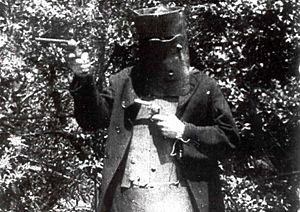
Australia's first film studio was created in Melbourne in 1898. The world's first feature-length film was the 1906 Australian movie The Story of the Kelly Gang. Early Australian films often told stories about bushrangers, gold mining, and colonial life. An enduring classic is The Sentimental Bloke (1919). After these early successes, Australian cinema faced challenges from Hollywood.
In 1933, Charles Chauvel directed In the Wake of the Bounty, starring Errol Flynn. Chauvel directed several successful Australian films, including Jedda (1955), the first Australian film in color and the first to feature Aboriginal actors in lead roles. In 2006, Ten Canoes was the first major film shot in an Indigenous language.
In the late 1960s and 1970s, government funding helped a new generation of filmmakers tell unique Australian stories. This era was called the Australian New Wave. Films like Picnic at Hanging Rock gained international attention. The 1980s brought more successes, including Gallipoli, The Man From Snowy River, "Crocodile" Dundee, and the Mad Max series.
The 1990s saw successful comedies like Muriel's Wedding and Strictly Ballroom, which helped launch the careers of Toni Collette and Baz Luhrmann. Australian humor is a big part of Australian films, often making fun of themselves. Comedies like Babe (1995) and The Castle are among the top-grossing Australian films. Many Australian stars like Russell Crowe and Cate Blanchett found success in Hollywood.
Australian Music
Indigenous Music
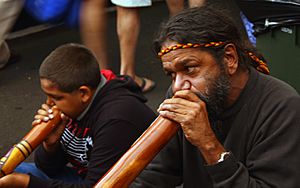
Music is a very important part of Aboriginal culture. The most famous instrument is the didgeridoo, used by Aboriginal tribes in northern Australia. Its unique droning sound is now used by many non-Aboriginal musicians.
Aboriginal musicians have also found success in Western popular music. Pioneers include Lionel Rose and Jimmy Little. Modern examples are Archie Roach and Yothu Yindi. Geoffrey Gurrumul Yunupingu has gained international fame singing in English and the Yolngu language.
Folk Music and National Songs
Australia's national anthem is "Advance Australia Fair".
Early British and Celtic immigrants brought folk songs that were changed to Australian themes. "Bound for Botany Bay" tells of convicts sailing to Sydney. "The Wild Colonial Boy" is about bushrangers. "Click Go the Shears" describes the life of Australian shearers. Australia's most famous folk song, "Waltzing Matilda", was written by poet Banjo Paterson in 1895. It's still popular and is seen as "the nation's unofficial national anthem."
Well-known folk singers include Rolf Harris and John Williamson. Bush dance is a traditional Australian dance style with Celtic roots, often accompanied by instruments like the fiddle and accordion.
Classical Music
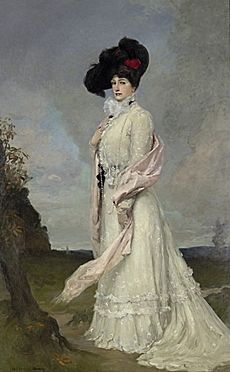
The first Western music in Australia came from free settlers (European classical music) and convicts/sailors (folk music from England, Ireland, Scotland, and Wales).
Nellie Melba became an internationally famous opera singer in the late 1800s. She was one of the best-known Australians of her time. In the mid-20th century, Australian classical composers like John Antill and Peter Sculthorpe were inspired by nature and Aboriginal culture.
Today, Australian classical music is very diverse. Composers like Liza Lim and Nigel Westlake combine different influences. Famous Australian classical performers include sopranos Dame Joan Sutherland and Emma Matthews, and pianists Roger Woodward and Eileen Joyce.
Popular Music
Johnny O'Keefe was the first Australian rock and roll artist to have a national hit with "Wild One" in 1958. Bands like The Easybeats and The Seekers became popular. The Bee Gees and AC/DC became famous in Australia before achieving international success. Australian artists continued to do well in the 1980s, including Cold Chisel, INXS, and Kylie Minogue. The ARIA Awards, held since 1987, are Australia's top music awards. Singer-songwriter Paul Kelly is often called the "poet laureate" of Australian music.
Australian country music has its own style, influenced by Celtic folk and bush ballads. Pioneers include Tex Morton and Smoky Dawson. Slim Dusty, known as the "King of Australian Country Music," released over 100 albums. His 1957 hit "A Pub With No Beer" was the first Australian single to sell enough copies to be called "gold." Other notable country artists include John Williamson and Kasey Chambers. The Tamworth Country Music Festival is held every year in Tamworth, the "Country Music Capital of Australia."
Australian Television
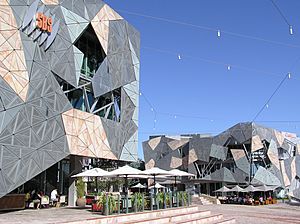
Television started in Australia on September 16, 1956, in Sydney. Color TV arrived in 1975. The Logie Awards are the main annual awards for Australian TV.
While US and British TV shows are popular, Australian-made content has also been very successful. Popular local shows include Skippy the Bush Kangaroo, Neighbours, and Home and Away. Many of these shows have been sold to other countries, like Steve Irwin's The Crocodile Hunter. Famous Australian TV personalities include Graham Kennedy and The Wiggles.
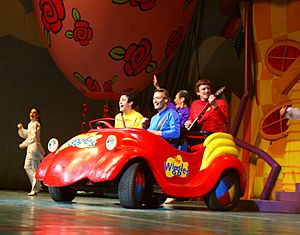
The Australian Broadcasting Corporation (ABC) is a government-funded public broadcaster. The Special Broadcasting Service (SBS) focuses on multicultural programs, broadcasting in many languages. Commercial TV networks include Seven Network, Nine Network, and Network Ten. Pay TV providers include Foxtel. The Australia Network broadcasts Australian TV to over 44 countries in Asia and the Pacific.
The ABC has produced popular TV dramas and comedies. Australian law requires commercial networks to show at least 55% Australian content between 6 a.m. and midnight.
Religion in Australia
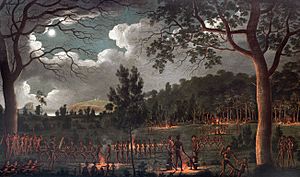
Australia has no official state religion. The Australian Constitution protects freedom of religion. In 2011, 61.1% of Australians identified as Christian. A growing number of people, 22.3%, said they had "no religion." There are also growing communities of other religions.
Christianity has had a lasting impact on Australia. In 1901, 97% of Australians were Christian. The Roman Catholic Church became the largest Christian group in 1986. Christian holidays like Christmas and Easter are national public holidays. Christian charities, hospitals, and schools have been important for welfare and education since colonial times. Mary MacKillop, who started an order of nuns, became the first Australian Catholic saint in 2010.
The number of Christians in Australia has decreased, while non-Christian religions have grown. Buddhism and Islam have increased due to immigration. The history of the Jews in Australia dates back to the First Fleet. Hindus also came to Australia in the 1800s, and their numbers have grown significantly.
Aboriginal Australian spirituality focuses on the role of Elders in passing down stories of the Dreaming. This belief system respects the land, animals, and spirits.
Public Holidays
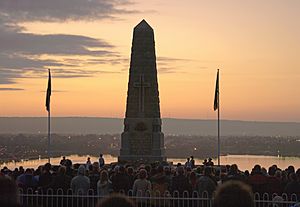
Australia's public holidays start with New Year's Day. Australia Day is celebrated on January 26, marking the arrival of the British. Anzac Day, on April 25, honors Australians who fought in wars, especially the soldiers who landed at Gallipoli in 1915 during World War I.
The Christian festivals of Easter and Christmas are also public holidays. Christmas Day, December 25, falls during the Australian summer.
Labour Day is a public holiday, but the date varies by state. The King's Birthday is usually in June. On this day, and on Australia Day, national awards are given to important citizens.
Australian Food
Modern Australian food mixes British, Indigenous, Mediterranean, and Asian influences. Australia has many quality meats. Barbecuing beef or lamb outdoors is a cherished national tradition. Most Australians live near the sea, and Australian seafood restaurants are highly rated.
Bush tucker refers to native Australian plant and animal foods. These include bush fruits like kakadu plums and finger limes, fish, shellfish, and meats like emu and kangaroo. Many Indigenous Australians still hunt and gather these foods. The macadamia nut is a famous bushfood sold widely.
Early British settlers brought familiar meats and crops from Europe. "Meat and three veg", fish and chips, and the Australian meat pie are still traditional meals. After World War II, migrants from Greece, Italy, Vietnam, and China brought new flavors and diversified the diet.
Australia's large fishing zone provides easy access to seafood. Lobster, prawns, tuna, and salmon are commercially harvested. Aquaculture (farming seafood) also produces many species.
Vegemite is a well-known Australian spread. Famous Australian desserts include pavlova and lamingtons. ANZAC biscuits remind people of the food eaten by Australian soldiers in World War I.
Clothing and Style
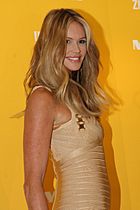
Australia doesn't have an official national dress, but iconic local styles include bushwear and surfwear. Australian Fashion Week showcases Australian and Asia Pacific designers. Top Australian models include Elle Macpherson and Miranda Kerr.
Bushwear brands include Akubra hats, Driza-Bone coats, and R.M. Williams clothing. The cabbage tree hat was the first unique Australian headwear, dating back to the early 1800s. The cork hat, with corks hanging from the brim, was used to keep flies away in the outback.
World-famous Australian surfwear brands include Billabong and Rip Curl. Australian surfers popularized the ugg boot, a sheepskin boot that became a global fashion trend.
The slouch hat was first worn by Australian military forces in 1885. It became standard army headgear in 1903 and is now an important national symbol.
Australians generally have a relaxed attitude towards beachwear. Over time, swim briefs, known as speedos or budgy smugglers, became iconic swimwear for Australian men.
Australian Stories and Beliefs
Australian stories and legends are culturally important. For example, the bushranger Ned Kelly is often seen as a mix of an underdog and a Robin Hood figure.
Australians have served in many wars overseas. Australian war culture focuses on solemn reflection and honoring sacrifice.
Some people have criticized Australian culture for being "low-brow." The term "cultural cringe" describes a feeling of national inferiority, where people assume ideas from other places are better. However, this feeling has lessened in the 21st century.
The phrase "the lucky country" was used by Donald Horne to describe Australia's good weather, lifestyle, and history. Ironically, Horne used it to criticize Australians for being too relaxed in the 1960s.
"Mateship," or loyal friendship, is a key value, especially between men, but now also between men and women. It comes from the difficulty of settling the land, where people had to support each other to survive. This led to the nickname "Aussie battler" for a hardworking Australian.
Australians often use short forms of names (e.g., Johnno for John). This shows affection and acceptance.
Because of "mateship," Australian society is generally anti-hierarchical. Australians are expected to be humble and not act better than others. Disloyalty to "mates" is frowned upon, known as the tall poppy syndrome. This means people who become too successful or arrogant are often criticized. This makes Australian society seem "laid-back." Most people use first names or nicknames.
The "mateship" culture and its history have created a lack of respect for authority, especially if it seems arrogant. Politicians are often viewed with distrust. This egalitarian system means leaders must connect with ordinary people.
Australians also support the "underdog"—those who seem to be at a disadvantage. This is linked to the belief in a "fair go," meaning a fair chance or opportunity. This belief is a key part of Australian culture. It supports public health and education systems and equal opportunity laws.
Sport in Australia
Many Australians love sport, both watching and playing. Cricket is popular in summer, and different types of football are popular in winter. Australian traditions like grand finals and footy tipping are shared across sports.
Australia's success in events like the Olympic Games, Commonwealth Games, and World Cups in cricket, rugby union, rugby league, and field hockey is a source of national pride. Sports stars like Donald Bradman and Cathy Freeman are highly respected.
Cricket
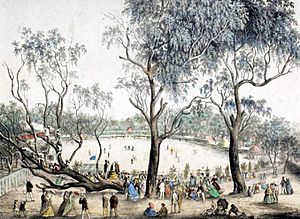
Cricket is Australia's most popular summer sport and has been played since colonial times. It is followed in all states.
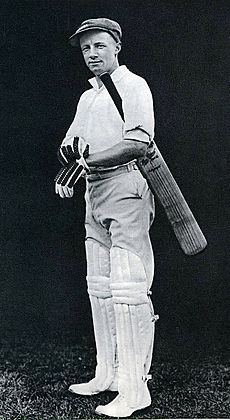
The first recorded cricket match in Australia was in Sydney in 1803. The first Test match was played in Melbourne in 1877 between Australia and England. A famous Australian victory in England in 1882 led to the creation of the Ashes series, a major rivalry between the two countries.
Successful cricketers become lasting celebrities. Sir Donald Bradman is considered the greatest batsman ever. Other famous cricketers include Shane Warne. Australia has often been at the top of the cricketing world.
Football Sports
Australian rules football has the highest attendance of any spectator sport in Australia. It started in Melbourne in the 1850s and is the world's oldest major football code. The national competition, the Australian Football League (AFL), is very popular. The AFL Grand Final is played in Melbourne.
Rugby union was first played in Australia in the 1860s. The national team, the Wallabies, has won the Rugby World Cup twice.
In 1908, rugby league was created as a professional sport. It became more popular than rugby union in Australia. The top competition is the National Rugby League (NRL). The State of Origin series between New South Wales and Queensland is a major event. Australia's national team, the Kangaroos, has won 11 Rugby League World Cup titles.
Soccer has the highest participation rate of any football code in Australia. The A-League is the national league. The national team, the Socceroos, has competed in five FIFA World Cup championships.
Water Sports
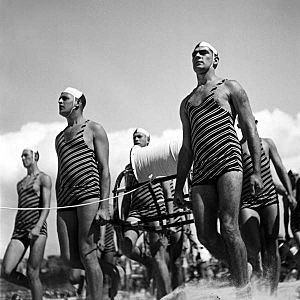
Australia's warm climate and many beaches are perfect for water sports like swimming and surfing. Most Australians live near the coast, so beaches are very popular.
Swimming is a popular activity. In the early 1900s, the Australian Cavill family helped develop the crawl stroke. Australia is a world leader in Olympic swimming, with many gold medals. Swimmers like Dawn Fraser and Ian Thorpe are famous.
Australians have a special connection to surf lifesaving. The world's first surf lifesaving club was founded at Bondi Beach in Sydney in 1906. Surf Life Saving Australia has performed hundreds of thousands of rescues.
In 1915, Duke Kahanamoku from Hawaii introduced surf board riding to Sydney, starting Australia's love for surfing. More Australians have been declared world surfing champions than any other nation.
The Sydney to Hobart Yacht Race is a popular event. Australia won the America's Cup in 1983, the first country other than the United States to do so.
Other Sports
Horse racing has been important in Australian culture since colonial times. The Melbourne Cup, first run in 1861, is known as "the race that stops a nation."
Basketball is popular, especially among children. The National Basketball League (NBL) is the top men's league. Netball has the highest participation rate of any women's sport in Australia. The Australian national netball team is considered the best in the world.
The Australian V8 Supercars series is growing in popularity. Australia regularly has world champion field hockey teams. Australian cyclists have won international competitions, like Cadel Evans winning the 2011 Tour de France.

Snow sports are enjoyed in the Australian Alps and Tasmania. Skiing in Australia began in the 1860s. Major alpine skiing resorts include Thredbo and Perisher. Australia has won medals at the Winter Olympics.
Australians have also found success in American sports like baseball, ice hockey, and American football.
Images for kids
-
The University of Sydney.
See also
 In Spanish: Cultura de Australia para niños
In Spanish: Cultura de Australia para niños


